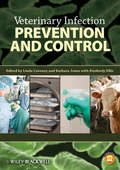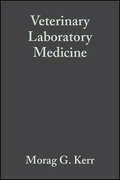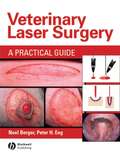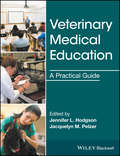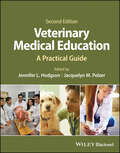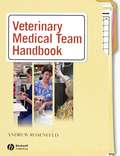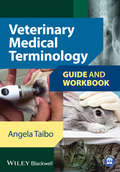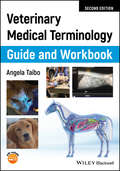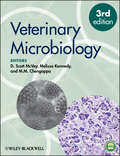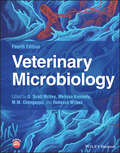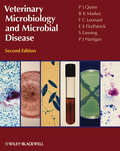- Table View
- List View
Veterinary Infection Prevention and Control
by Linda Caveney Barbara Jones Kimberly EllisVeterinary Infection Prevention and Control is a practical guide to infection surveillance and control in the veterinary setting. Outlining the steps for designing and implementing an infection control plan, the book offers information on both nosocomial infections and zoonotic diseases to aid the veterinary team in ensuring that veterinary practices and hospitals are safe for both the animal patients and their human caregivers. Veterinary Infection Prevention and Control provides guidelines to creating standard operating procedures for effective and efficient infection control in any veterinary practice. With background information on pathogens, bacteria, and disease transmission, the book focuses on specific infection prevention strategies, including disinfection, sterilization, and isolation. A companion website provides review questions and the figures from the book in PowerPoint. Veterinary Infection Prevention and Control gives practicing veterinarians, technicians, and practice managers in both small and large animal facilities the tools they need to successfully develop an infection-control program.
Veterinary Instruments and Equipment - E-Book: A Pocket Guide
by Teresa F. SonsthagenUse this pocket guide to learn veterinary instruments and equipment at a glance! Veterinary Instruments and Equipment, Third Edition shows hundreds of detailed, full-color photographs of instruments and describes how and when each is used. A flashcard-style format makes it easy to flip through the pages, so you will quickly become familiar with commonly used equipment. An Evolve companion website includes instrument photographs that may be rotated 360 degrees so that you can zoom in to see close-ups of the different tips. With this knowledge, you’ll prove a valuable member of the clinical team!400 high-quality color photographs help you quickly become familiar with instruments.A flip book, flashcard format makes it easy to learn veterinary instruments and equipment.Coverage of surgical instruments includes general instruments such as hemostats, forceps, and scissors, and describes orthopedic, ophthalmic, and dental instruments used in veterinary specialty surgeries.Coverage of restraint equipment includes proper restraint techniques for all species of large and small animals. Instruments and equipment shown for common procedures for small and large animals, including bovine, equine, sheep, pigs, and goats, and include procedures such as dehorning, hoof care, castration, and teat and obstetrical procedures.An Evolve companion website includes all of the photos from the book plus images of 30 instruments in a zoom-and-rotate format, allowing you to focus in on instrument details including the different tips.Two pages are allotted to each instrument, with the top page including a photo and the bottom page including the instrument’s name, functions, and characteristics.Spiral binding allows the book to lay flat or fold over so that only the instrument or description is visible. NEW photographs of veterinary instruments, including: Bair Hugger warming unitCentrifuges: small (urine), medium (blood), and large (fecal)MicroscopeAutoclave (steam and gas)Surgical table (V table and flat table)SuctionMicrochip implanterAnal gland excision kitUPDATED photographs provide improved resolution of images.
Veterinary Instruments and Equipment - E-Book: A Pocket Guide
by Teresa F. SonsthagenLearn the names and uses of veterinary instruments in details textbooks alone can't provide! Veterinary Instruments and Equipment: A Pocket Guide, 4th Edition shows hundreds of detailed, full-color photographs of instruments and describes how and when each is used. A flashcard-style format makes it easy to flip through the pages, so you will quickly become familiar with commonly used equipment. This new edition features updated photographs, new instruments, and an all-new appendix with the author’s recommended list of instruments essential for the most-common veterinary surgical kits, including ambulatory, orthopedic, and major surgery packs. Plus, an Evolve companion website includes instrument photographs that may be rotated 360 degrees, so you can zoom in to see close-ups of the different tips.Accompanying Evolve site uses an interactive format giving you the ability to conveniently study and learn instruments to which you’d normally have only limited accessInstruments and equipment shown for common procedures for small and large animals, including bovine, equine, sheep, pigs, and goats, and include procedures such as dehorning, hoof care, castration, and teat and obstetrical procedures.Coverage of surgical instruments includes general instruments such as hemostats, forceps, and scissors, and describes orthopedic, ophthalmic, and dental instruments used in veterinary specialty surgeries.Coverage of restraint equipment includes proper restraint techniques for all species of large and small animals. Handy pocket size and spiral binding allows the book to lay flat or fold over so that only the instrument or description is visible.Accompanying Evolve site uses an interactive format giving students the ability to conveniently study and learn instruments to which they normally have only limited access.400 high-quality color photographs help you to quickly become familiar with instruments.A flip book, flashcard format makes it easy for you to learn veterinary instruments and equipment.NEW! Thoroughly updated photographs throughout ensures you are studying the most up-to-date instruments on the market. NEW! Topics throughout the text include: Spay (Ovariohysterectomy) PacksNeuter (Orchiectomy) Surgical PackNeuter (Orchiectomy) Surgical PackGeneral Surgical PackOrthopedic Surgical PackOphthalmic Surgical InstrumentsDental Prophylaxis KitDental Periodontal Extraction Kit
Veterinary Laboratory Medicine: Clinical Biochemistry and Haematology
by Morag G. KerrVeterinary Laboratory Medicine covers all aspects of basic clinical biochemistry and haematology, and includes test-by-test interpretation of laboratory results. Information is provided on sampling techniques, the selection and use of an external laboratory, as well as near-patient testing and the practice laboratory. Also included are step-by-step instructions for most commonly used point-of-care tests, a guide to the evaluation of instruments for in-practice use, and a detailed explanation of the principles of impedance counting and photometric analysis. The book will be ideal for practitioners who require a guide to laboratory work, and for veterinary students studying laboratory medicine and clinical pathology. The second edition has been fully updated to reflect advances in diagnostic techniques, and includes new chapters on diagnostic endocrinology and feline virus testing as well as a much expanded chapter on diagnostic profiling and pattern recognition.
Veterinary Laser Surgery: A Practical Guide
by Noel A. Berger Peter H. EegSurgical and therapeutic use of lasers began in human medicine in the early 1960s. Technology and equipment advanced rapidly. Over the last ten years veterinarians have been exploring the many potential advantages that various lasers provide their patients. Because laser light energy can be applied directly to target tissue or administered to distant lesions at a remote site through fiberoptic components, laser surgery has become an invaluable and growing veterinary surgical resource. Unlike many medical technologies, the size, reliability, and portability of lasers have improved so rapidly that they are now both economically and practically feasible for the general and specialty veterinarian. Routine laser use in veterinary medicine stands poised to gain large-scale general acceptance for everyday routine and specialty procedures. Written by experts in the field, Veterinary Laser Surgery: A Practical Guide strives to help general and specialty veterinary practitioners understand, implement and expand the use of laser energy in safe and rational ways for both surgical and therapeutic procedures to further improvement the veterinarians ability to enhance the patient’s quality of life. PRACTICAL PICTORIAL GUIDE / ATLAS feature that includes 31 case studies of the most common laser surgery procedures. Broad spectrum of specific laser information, including chapters covering basic laser physics through specific laser surgery techniques and pain management. Special sections on CO2 and Diode laser wavelengths. Provides veterinarians with skills and techniques to improve the comfort and quality of patients’ lives through appropriate laser use. User-friendly format makes referencing easy. A practical reference for specialty and general veterinarians.
Veterinary Medical Education: A Practical Guide
by Jennifer L. Hodgson Jacquelyn M. PelzerVeterinary Medical Education: A Practical Guide offers a complete resource to fundamental information on key areas of veterinary education. Provides a practical guide to the key principles of veterinary medical education Takes a real-world approach, with concrete guidance for teaching veterinary skills and knowledge Covers all aspects of designing and implementing a veterinary curriculum Emphasizes key points and helpful tips Offers a veterinary-specific resource for any veterinary educator worldwide
Veterinary Medical Education: A Practical Guide
by Jennifer L. Hodgson Jacquelyn M. PelzerVeterinary Medical Education: A Practical Guide offers a complete resource to fundamental information on key areas of veterinary education. Provides a practical guide to the key principles of veterinary medical education Takes a real-world approach, with concrete guidance for teaching veterinary skills and knowledge Covers all aspects of designing and implementing a veterinary curriculum Emphasizes key points and helpful tips Offers a veterinary-specific resource for any veterinary educator worldwide
Veterinary Medical Education: A Practical Guide
by Jennifer L. Hodgson Jacquelyn M. PelzerVeterinary Medical Education Practical yet complete reference to all aspects of veterinary medical education?? Veterinary Medical Education: A Practical Guide, Second Edition offers a comprehensive reference to all aspects of veterinary medical education, providing concrete guidance for instructors in a variety of settings. The book gives real-world, practical, veterinary-specific advice on all aspects of designing and implementing a veterinary curriculum. This Second Edition includes new and expanded information on widening access on admissions, competency-based veterinary education, academic advising and student support, eLearning, transition to practice and career opportunities, educational leadership and global veterinary education. This revised edition has been significantly enhanced and updated, featuring twelve new chapters and many expanded chapters. It includes diagrams, figures, and informational boxes that highlight key points, clarify concepts, provide helpful tips and evidence from the literature, and examples of educational innovations that could be adopted in veterinary programs. Veterinary Medical Education covers: Student selection, including widening access Curricular innovations and competency-based veterinary education Learning theories, eLearning, and their application in the classroom Teaching in clinical and non-clinical settings and creating safe, inclusive learning environments Programmatic and technology-enhanced assessment, academic advising and study skills, coaching, and mentoring Professionalism and professional identity, cultural humility, and transition to practice Program evaluation, educational leadership, and global trends With comprehensive coverage of the field and a wealth of new and updated information, the Second Edition of Veterinary Medical Education is an indispensable resource for anyone involved with veterinary education, including instructors and faculty at veterinary colleges, continuing education instructors, veterinary technology instructors, and veterinarians training in internships and residencies.
Veterinary Medical Education: A Practical Guide
by Jennifer L. Hodgson Jacquelyn M. PelzerVeterinary Medical Education Practical yet complete reference to all aspects of veterinary medical education?? Veterinary Medical Education: A Practical Guide, Second Edition offers a comprehensive reference to all aspects of veterinary medical education, providing concrete guidance for instructors in a variety of settings. The book gives real-world, practical, veterinary-specific advice on all aspects of designing and implementing a veterinary curriculum. This Second Edition includes new and expanded information on widening access on admissions, competency-based veterinary education, academic advising and student support, eLearning, transition to practice and career opportunities, educational leadership and global veterinary education. This revised edition has been significantly enhanced and updated, featuring twelve new chapters and many expanded chapters. It includes diagrams, figures, and informational boxes that highlight key points, clarify concepts, provide helpful tips and evidence from the literature, and examples of educational innovations that could be adopted in veterinary programs. Veterinary Medical Education covers: Student selection, including widening access Curricular innovations and competency-based veterinary education Learning theories, eLearning, and their application in the classroom Teaching in clinical and non-clinical settings and creating safe, inclusive learning environments Programmatic and technology-enhanced assessment, academic advising and study skills, coaching, and mentoring Professionalism and professional identity, cultural humility, and transition to practice Program evaluation, educational leadership, and global trends With comprehensive coverage of the field and a wealth of new and updated information, the Second Edition of Veterinary Medical Education is an indispensable resource for anyone involved with veterinary education, including instructors and faculty at veterinary colleges, continuing education instructors, veterinary technology instructors, and veterinarians training in internships and residencies.
Veterinary Medical Team Handbook
by Andrew J. RosenfeldVeterinary medicine is a dynamic field allowing team members growth in every aspect of the science and profession. In a single day, a team member may be involved in administrative, emergency and critical care, internal medicine, surgical and radiological teams. With increasing expectations of quality care and technology, team members’ knowledge and responsibilities are growing at an exponential rate. The Veterinary Medical Team Handbook is designed as a training resource for veterinarians, technicians and staff. Coverage ranges from administrative tasks and client communication to common diseases, disorders and procedures. The aim is to increase the staff's ability to detect and manage health problems and to enable the team to be more effective communicators with each other and with clients. Two accompanying CD-ROMs contain training modules and interactive case studies for further learning and practice. A valuable training guide for veterinary practices and hospitals. Designed for easy reference with abundant bullet points, algorithms, lists and key point boxes. Covers common diseases, disorders and procedures, as well as administrative tasks and client communication. Includes two CD-ROMs with training modules and interactive case studies.
Veterinary Medical Team Handbook
by Andrew J. RosenfeldVeterinary medicine is a dynamic field allowing team members growth in every aspect of the science and profession. In a single day, a team member may be involved in administrative, emergency and critical care, internal medicine, surgical and radiological teams. With increasing expectations of quality care and technology, team members’ knowledge and responsibilities are growing at an exponential rate. The Veterinary Medical Team Handbook is designed as a training resource for veterinarians, technicians and staff. Coverage ranges from administrative tasks and client communication to common diseases, disorders and procedures. The aim is to increase the staff's ability to detect and manage health problems and to enable the team to be more effective communicators with each other and with clients. Two accompanying CD-ROMs contain training modules and interactive case studies for further learning and practice. A valuable training guide for veterinary practices and hospitals. Designed for easy reference with abundant bullet points, algorithms, lists and key point boxes. Covers common diseases, disorders and procedures, as well as administrative tasks and client communication. Includes two CD-ROMs with training modules and interactive case studies.
Veterinary Medical Terminology: Guide and Workbook
by Angela TaiboVeterinary Medical Terminology Guide and Workbook provides a user-friendly guide for gaining an understanding of veterinary medical terms, from phonetic spelling and meanings of prefixes, suffixes, and roots to more in-depth explanations of terminology. Introductory chapters explain the basic principles of using medical terminology in veterinary medicine, with later chapters organized by body system, covering anatomy, terminology, and abbreviations in a consistent format. Carefully designed to engage the reader, each chapter includes tip boxes, case studies, word lists, and review exercises to promote learning, and a companion website also provides a pronunciation guide, flash cards, teaching PowerPoints, and additional images. Species-specific chapters on the horse, ruminants, exotics, and lab animals offer a unique study of terms specific to these species, making this a truly comprehensive resource. Appendices provide quick access to information on the pronunciation, spelling, and meaning of word parts and commonly used abbreviations. Helpful to both veterinary and veterinary technician students and those in practice, Veterinary Medical Terminology Guide and Workbook is an essential resource to learning veterinary terminology and using correct medical terms in daily practice.
Veterinary Medical Terminology: Guide and Workbook
by Angela TaiboVeterinary Medical Terminology Guide and Workbook provides a user-friendly guide for gaining an understanding of veterinary medical terms, from phonetic spelling and meanings of prefixes, suffixes, and roots to more in-depth explanations of terminology. Introductory chapters explain the basic principles of using medical terminology in veterinary medicine, with later chapters organized by body system, covering anatomy, terminology, and abbreviations in a consistent format. Carefully designed to engage the reader, each chapter includes tip boxes, case studies, word lists, and review exercises to promote learning, and a companion website also provides a pronunciation guide, flash cards, teaching PowerPoints, and additional images. Species-specific chapters on the horse, ruminants, exotics, and lab animals offer a unique study of terms specific to these species, making this a truly comprehensive resource. Appendices provide quick access to information on the pronunciation, spelling, and meaning of word parts and commonly used abbreviations. Helpful to both veterinary and veterinary technician students and those in practice, Veterinary Medical Terminology Guide and Workbook is an essential resource to learning veterinary terminology and using correct medical terms in daily practice.
Veterinary Medical Terminology E-Book
by Dawn E. ChristensonReader-friendly and organized by body system, Veterinary Medical Terminology, 3rd Edition helps you quickly gain a solid understanding of veterinary terminology. Essential word parts and terms are presented in the context of basic anatomy, physiology, and disease conditions, giving you the tools to immediately apply new terminology to practical clinical situations. This new edition features learning exercises at the end of each chapter to reinforce content and test your knowledge, challenging you to go beyond simple memorization and become fluent in the language of veterinary medicine. Updated coverage includes advancements in the vet tech field, new medications, treatments of today’s most prevalent diseases, and the latest procedures in orthopedics. This third edition is an essential resource for learning the medical terms and basic principles of veterinary medicine.
Veterinary Medical Terminology Guide and Workbook
by Angela TaiboDesigned to be both comprehensive and user-friendly, the text offers easy-to-understand explanations of medical terminology and contains helpful learning features such as tips, case studies, and review questions. Describes medical terms with easy-to-understand explanations and phonetic spellings Offers an updated edition of this practical guide to veterinary medical terminology Contains real-world case studies, word lists, and review questions that are designed to promote active learning Includes new chapters on medical reports and case studies and large animals, as well as helpful memorization features Provides access to a companion website with images, audio clips, flash cards, and other helpful learning tools
Veterinary Medical Terminology Guide and Workbook
by Angela TaiboDesigned to be both comprehensive and user-friendly, the text offers easy-to-understand explanations of medical terminology and contains helpful learning features such as tips, case studies, and review questions. Describes medical terms with easy-to-understand explanations and phonetic spellings Offers an updated edition of this practical guide to veterinary medical terminology Contains real-world case studies, word lists, and review questions that are designed to promote active learning Includes new chapters on medical reports and case studies and large animals, as well as helpful memorization features Provides access to a companion website with images, audio clips, flash cards, and other helpful learning tools
Veterinary Medicine - E-BOOK: A textbook of the diseases of cattle, horses, sheep, pigs and goats
by Peter D. Constable Kenneth W Hinchcliff Stanley H. Done Walter GruenbergTreat the diseases affecting large animals! Veterinary Medicine, 11th Edition provides up-to-date information on the diseases of horses, cattle, sheep, goats, and pigs. Comprehensive coverage includes the principles of clinical examination and making a diagnosis, along with specific therapy recommendations. For easier use, this edition has been divided into two volumes and restructured into a logical, anatomically based approach to disease. From internationally known veterinary experts Peter Constable, Kenneth Hinchcliff, Stanley Done, and Walter Grünberg, this book is the definitive, one-stop reference for farm animal and equine care.Comprehensive coverage includes information essential to any large-animal veterinarian, especially those working with horses, cattle, sheep, goats, or pigs. Coverage of diseases addresses major large-animal diseases of all countries, including foreign animal and emerging diseases.User-friendly format makes it easier to quickly absorb key information. Quick review/synopsis sections make important information on complex diseases easy to find. NEW! Convenient, easy-access format is organized by organ systems, and divides the content into two compact volumes with the same authoritative coverage.Nearly 200 new color photographs and line drawings are included in this edition.NEW full-color design improves navigation, clarifies subject headings, and includes more boxes, tables, and charts for faster reference.New Diseases Primarily Affecting the Reproductive System chapter is added.Updated and expanded chapter on pharmacotherapy lists therapeutic interventions and offers treatment boxes and principles of antibiotic use.Expanded sections on herd health include biosecurity and infection control, and valuable Strength of Evidence boxes.NEW or extensively revised sections include topics such as the Schmallenberg and Bluetongue viral epidemics of ruminants in Europe, Wesselbron disease in cattle, hypokalemia in adult cattle, equine multinodular pulmonary fibrosis, Hendra virus infection, porcine reproductive and respiratory syndrome, torque teno virus, and numerous recently identified congenital and inherited disorders of large animals.Additional content is provided on lameness in cattle and the diseases of cervids.
Veterinary Medicine E-Book: A textbook of the diseases of cattle, horses, sheep, pigs and goats
by O.M. Radostits, C.C. Gay, K.W. Hinchcliff, P.D. ConstableThe new 10th edition of this well-respected reference includes thoroughly revised and reviewed information with content on new diseases for the most up-to-date information on diseases effecting sheep, pigs, goats, horses, and cattle. Divided into two sections, General Medicine and Special Medicine, the book covers topics ranging from the clinical examination and manifestation of disease in organ systems to specific diseases of the large animal species.Includes important information essential to any large-animal veterinarian, especially those working with horses, cattle, sheep, pigs, or goats.User-friendly format allows the reader to quickly absorb key information.Quick review/synopsis sections for complex diseases make important information easy to find.Features content on major diseases of all countries, including foreign animal and emerging diseases.Completely revised chapters reflect the information from current literature.New chapters address diseases associated with prions and identify important emerging diseases.A new main author who is a recognized authority on internal medicine of ruminant species with extensive clinical experience and scientific publications brings his expertise to this important reference.Includes content from contributing authors who are international authorities on pig diseases, toxicological disease in animals, and diseases associated with artropod parasites.Several new illustrations and sonograms provide up-to-date visual aids for better understanding.
Veterinary Microbiology: A Practitioners Guide To Microbiological Diagnostic Testing (Wiley Desktop Editions Ser.)
by D. Scott McVey Melissa Kennedy M. M. ChengappaVeterinary Microbiology, Third Edition is a comprehensive reference on the bacterial, fungal, and viral pathogenic agents that cause animal disease. Now in full color with improved images throughout, the new edition has been thoroughly updated to reflect information from current research and diagnostic and clinical publications. Key changes include a review of microbial cell structure and function and increased emphasis on the key points of pathogenesis and host responses to infection. Organized into four sections, the Third Edition begins with an updated and expanded introductory section on infectious disease pathogenesis, diagnosis and clinical management. The second section covers bacterial and fungal pathogens, and the third section describes viral diseases and viruses. The final section presents a systematic approach of describing infection and disease of animals. Equally useful for beginning veterinary students and seasoned practitioners, Veterinary Microbiology offers a thorough introduction and reference text for veterinary infectious disease.
Veterinary Microbiology
by D. Scott McVey Melissa Kennedy M. M. ChengappaVeterinary Microbiology, Third Edition is a comprehensive reference on the bacterial, fungal, and viral pathogenic agents that cause animal disease. Now in full color with improved images throughout, the new edition has been thoroughly updated to reflect information from current research and diagnostic and clinical publications. Key changes include a review of microbial cell structure and function and increased emphasis on the key points of pathogenesis and host responses to infection. Organized into four sections, the Third Edition begins with an updated and expanded introductory section on infectious disease pathogenesis, diagnosis and clinical management. The second section covers bacterial and fungal pathogens, and the third section describes viral diseases and viruses. The final section presents a systematic approach of describing infection and disease of animals. Equally useful for beginning veterinary students and seasoned practitioners, Veterinary Microbiology offers a thorough introduction and reference text for veterinary infectious disease.
Veterinary Microbiology
by D. Scott McVey Melissa Kennedy M. M. Chengappa Rebecca WilkesVeterinary Microbiology Comprehensive reference work on the bacterial, fungal, and viral pathogens that cause animal diseases Veterinary Microbiology, Fourth Edition presents comprehensive information based on the most recent research, diagnostic, and clinical publications for bacterial, fungal, and viral animal diseases. The information provided is intended to be most relevant for veterinary students and practitioners. The text is supported throughout by high-quality and full-color images to aid learning. A companion website offers chapter content, supplemental information, and figures from the book in PowerPoint format. Sample topics discussed within the book include: Pathogenic bacteriology: includes major classifications and genera of bacteria associated with veterinary infectious disease Pathogenic mycology: dermatophytes, agents of subcutaneous mycoses, and agents of systemic mycoses Pathogenic virology: includes RNA and DNA viruses as well as prions associated with veterinary infectious disease
Veterinary Microbiology
by D. Scott McVey Melissa Kennedy Rebecca Wilkes M. M. ChengappaVeterinary Microbiology Comprehensive reference work on the bacterial, fungal, and viral pathogens that cause animal diseases Veterinary Microbiology, Fourth Edition presents comprehensive information based on the most recent research, diagnostic, and clinical publications for bacterial, fungal, and viral animal diseases. The information provided is intended to be most relevant for veterinary students and practitioners. The text is supported throughout by high-quality and full-color images to aid learning. A companion website offers chapter content, supplemental information, and figures from the book in PowerPoint format. Sample topics discussed within the book include: Pathogenic bacteriology: includes major classifications and genera of bacteria associated with veterinary infectious disease Pathogenic mycology: dermatophytes, agents of subcutaneous mycoses, and agents of systemic mycoses Pathogenic virology: includes RNA and DNA viruses as well as prions associated with veterinary infectious disease
Veterinary Microbiology and Microbial Disease
by P. J. Quinn B. K. Markey F. C. Leonard P. Hartigan S. Fanning E. S. FitzpatrickMicrobiology is one of the core subjects for veterinary students, and since its first publication in 2002, Veterinary Microbiology and Microbial Disease has become an essential text for students of veterinary medicine. Fully revised and expanded, this new edition updates the subject for pre-clinical and clinical veterinary students in a comprehensive manner. Individual sections deal with bacteriology, mycology and virology. Written by an academic team with many years of teaching experience, the book provides concise descriptions of groups of microorganisms and the diseases which they cause. Microbial pathogens are discussed in separate chapters which provide information on the more important features of each microorganism and its role in the pathogenesis of diseases of animals. The international and public health significance of these pathogens are reviewed comprehensively. The final section is concerned with the host and is organized according to the body system affected. Tables, boxes and flow diagrams provide information in an easily assimilated format. This edition contains new chapters on molecular diagnostics and on infectious conditions of the skin, cardiovascular system, urinary tract and musculoskeletal system. Many new colour diagrams are incorporated into this edition and each chapter has been updated. Key features of this edition: Twelve new chapters included Numerous new illustrations Each chapter has been updated Completely re-designed in full colour Fulfils the needs of veterinary students and academics in veterinary microbiology Companion website with figures from the book as Powerpoints for viewing or downloading by chapter: www.wiley.com/go/quinn/veterinarymicrobiology Veterinary Microbiology and Microbial Disease remains indispensable for all those studying and teaching this essential component of the veterinary curriculum.
Veterinary Microbiology and Microbial Disease
by P. J. Quinn B. K. Markey F. C. Leonard P. Hartigan S. Fanning E. S. FitzpatrickMicrobiology is one of the core subjects for veterinary students, and since its first publication in 2002, Veterinary Microbiology and Microbial Disease has become an essential text for students of veterinary medicine. Fully revised and expanded, this new edition updates the subject for pre-clinical and clinical veterinary students in a comprehensive manner. Individual sections deal with bacteriology, mycology and virology. Written by an academic team with many years of teaching experience, the book provides concise descriptions of groups of microorganisms and the diseases which they cause. Microbial pathogens are discussed in separate chapters which provide information on the more important features of each microorganism and its role in the pathogenesis of diseases of animals. The international and public health significance of these pathogens are reviewed comprehensively. The final section is concerned with the host and is organized according to the body system affected. Tables, boxes and flow diagrams provide information in an easily assimilated format. This edition contains new chapters on molecular diagnostics and on infectious conditions of the skin, cardiovascular system, urinary tract and musculoskeletal system. Many new colour diagrams are incorporated into this edition and each chapter has been updated. Key features of this edition: Twelve new chapters included Numerous new illustrations Each chapter has been updated Completely re-designed in full colour Fulfils the needs of veterinary students and academics in veterinary microbiology Companion website with figures from the book as Powerpoints for viewing or downloading by chapter: www.wiley.com/go/quinn/veterinarymicrobiology Veterinary Microbiology and Microbial Disease remains indispensable for all those studying and teaching this essential component of the veterinary curriculum.
Veterinary Microbiology - E-Book: Bacterial and Fungal Agents of Animal Disease
by J. Glenn Songer Karen W. PostContaining the latest information on pathogenesis and diagnosis, Veterinary Microbiology addresses both specific, defined problems, as well as trends in host/parasite interaction. This book is a complete reference on microbial biology, diseases, diagnosis, prevention, and control. It also provides a foundation of knowledge on pathogens and how they interact with hosts.Contains a comprehensive, up-to-date overview of bacterial and fungal agents that cause animal disease, including recently identified organisms as well as the pathogenesis of emerging diseases.Features more than 100 full-color illustrations to visually reinforce key concepts.The book is logically organized for ease of use and quick reference in the clinical setting.Addresses diseases that can affect animal productivity, both for individual animals as well as herd health.Discusses the implications of various organisms in biological warfare and bioterrorism.
